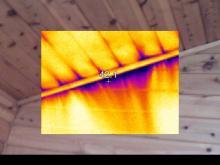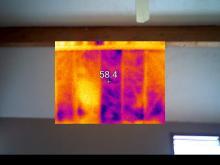- Energy Testing
- Insulation
- Windows
- Radon Mitigation
- Energy Solutions
- Attic Air Sealing
- Attic Insulation
- Attic Ventilation
- Rim Joists: Insulation and Air Sealing
- Rooms above garages
- Sidewalls (Open & Closed Cavities)
- Sloped & Vaulted Ceilings
- Bathroom Exhaust Fans
- Basement Walls
- Story-and-a-half Homes: Cape Cod, Salt Box, Modified A-Frame, Bungalow
- Crawlspace Moisture Control & Insulation
- Insulation Cantilevered floors
- Ice Dams
- Rebates & Incentives
Maintaining adequate ventilation in a “Cape Cod” home, a “Story and a Half” home, “A-Frame” home, or home with a vaulted ceiling requires some special approaches. See our pages on story-and-a-half homes for more information.
Sloped Ceilings
Vaulted ceilings and cathedral ceilings create grand interior spaces, but are often difficult to properly insulate and ventilate. Made up of enclosed rafters often no deeper than 6”, these types of ceilings offer little room for packing in insulation, which makes achieving the necessary R30+ for containing heat and eliminating ice damming in our Western Wisconsin and Twin Cities Metro area homes a real challenge.
Ideally, vaulted ceilings should be:

Air sealed
Air sealing for vaulted and cathedral ceilings is a relatively easy requirement, as long as the ceiling is drywalled. Our teamdoes simple sealing of penetrations like light boxes and recessed fixtures. If the ceiling is tongue-and-groove paneled, chances are more leakage will result. At a minimum, the perimeter of a paneled vault should be sealed with a silicone sealant.

Well Insulated
In some cases, the rafters of a vaulted ceiling may be deep enough to accommodate sufficient insulation. Additional insulation can often be blown in over a vault from an adjacent attic space or from outside (typically through the ridge of the roof). If it’s time for a new roof anyway, now is the perfect opportunity to both air seal and insulate your vaulted attic by tearing off roof sheathing and spray foam insulating the space from above. Whatever the case, whatever the material, a minimum of R30 insulation needs to be applied in these spaces. Enough room should also be left for ventilation.
Ventilated
Keeping the roof decking cool limits the growth of ice dams in winter and blocks heat buildup in the summer. In order to keep the roof decking cool, a continuous ventilation channel should run from the eave to the peak in a vaulted attic. Often overlooked by builders and remodelers, ventilation can be opened up (in some cases) by inserting vent chutes from above, or from the exterior (like when retrofitting spray foam). Each rafter cavity should be able to “breathe” into a ventilated soffit space at the eave, and should terminate at the high side of the roof to a continuous ridge vent.
If your Western WI or Twin Cities area home has sloped ceilings and could use some extra attention, don’t wait to fix it. Call us today to schedule your air sealing, insulation, and ventilation appointments!
Contact UsEnergy Assessments for $450 or less
Schedule your FREE Home Estimate
Testimonials
Gina & Neil J., Wilson, WI
Dear St. Croix Energy Solutions - thank you for everything! We love how much warmer our house is now! No more drafts to deal with. The customer service we received was exceptional from the office staff to the installers! Top notch service! We're so glad we learned about your business! Blessings and lots of thanks.
